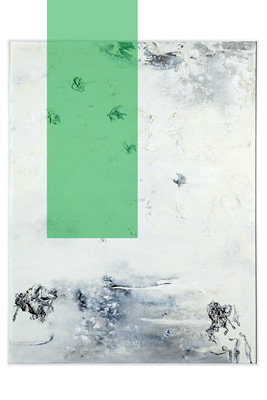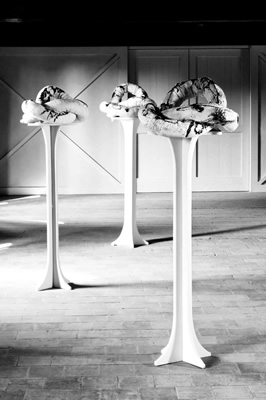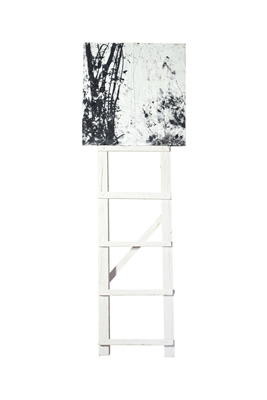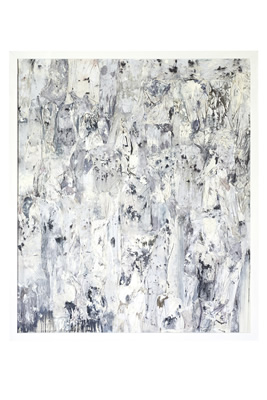
Whenever Brigitta Rossetti tackles a new set of artistic achievements, there is always a guiding line which is not to be intended as a unique expressive trend, yet as life style, daily experience and vision of the world.
The Passi Verdi (Green Steps) cycle is based on the same logic: what the artist feels in her inner self and perceives as a social phenomenon, will be transferred onto her works which, in this instance, aim at highlighting the primeval power of nature in a sort of surrealist dimension which, however, heralds a very precise message: it is still possible to have faith in a different world, a return to the pristine origins of spirit and man, of nature and beauty, which has always been the everlasting aspiration of art.
Brigitta Rossetti's life history smoothly leads towards such themes; actually she was born at the heart of the countryside near Piacenza, where she still works and where she spent her childhood amid corn fields, mooing herds out to pasture, the rhythms of nature to mark the passing of time, glorious sunsets behind the skyline of century-old trees.
 What has helped Brigitta Rossetti become the present artist is also the fact that she was born, grew and has lived at the heart of such scenery. She was born in a border land where restlessness seems to be the urging attitude, yet she has managed to turn her mood into strength and thus let her vision of art find unrestrained expression. Her Passi Verdi cycle was first exhibited at the Science Museum in Turin on the occasion of the UN-sponsored International Energy Year: a theme that has always greatly affected the artist. What has helped Brigitta Rossetti become the present artist is also the fact that she was born, grew and has lived at the heart of such scenery. She was born in a border land where restlessness seems to be the urging attitude, yet she has managed to turn her mood into strength and thus let her vision of art find unrestrained expression. Her Passi Verdi cycle was first exhibited at the Science Museum in Turin on the occasion of the UN-sponsored International Energy Year: a theme that has always greatly affected the artist.
“We keep on walking until we come into sight of what we used to see when we were children, with the same eyes and heart”.
The exhibition hosts works accompanied by a poem or a few lines by Giovanni Pascoli, who has always been an inspirational resource for Brigitta, which encourage to be filled with wonder when looking, step by step, at the new world that is being born, to name things, to look at and listen to things with childish, innocent eyes and ears.
 The technique used for the installation required a green plexiglass screen to offer an innovative vision of the works. That choice was a pleasant surprise for the visitors, yet it did not affect the presentation of the artistic work, which can be looked at in its real essence. The work image doubling caused by the plexiglass screen has enabled the artist to create a superimposition of languages, yet that film tend to rapidly vanish in front of the power of signs and words that go with its discovery. The technique used for the installation required a green plexiglass screen to offer an innovative vision of the works. That choice was a pleasant surprise for the visitors, yet it did not affect the presentation of the artistic work, which can be looked at in its real essence. The work image doubling caused by the plexiglass screen has enabled the artist to create a superimposition of languages, yet that film tend to rapidly vanish in front of the power of signs and words that go with its discovery.
A clear example is offered by “Sopra quel nero vidi, roseo”! (Over that black I saw, rosy...) which hides a kneeling-stool evocative of those small altars, the simple meeting points with the divine, you may suddenly come across alongside country roads. Kneeling down in front of nature is not enough: we need a key, therefore the artist evokes such necessity by means of a small old lock nailed onto the lower side of the table and another lock just above it, at the very heart of the work. The space is occupied by faint pigments, chrysanthemum (in Italy symbolic of death and used on graves) and peach blossoms, a sort of secular thanksgiving hosanna. Another instance are the souls of flowers the artist created in her “Fiore di carta rigido dentato“ (Stiff dentate paper flower), which are metaphors of life and death, of our lost simplicity that only art can arouse in man's inner existence.
Also the “Fior del poeta” (Poet's flowers) grow and burst into bloom; they are a metaphysical, ancestral presence, almost prehistoric and highly imaginative in their surreal significance. They are like totems made of wood, paper, pigments and absorbent pads used in water and land sewage and poison purification.
Just like a second Alice in Wonderland, Brigitta Rossetti leads us up an ancient staircase in search of our own identity, history and future, to reach a verdant, idyllic wood, a new world ruled by respect and freedom where body and soul can eventually regain their original osmosis. Thus the “Dileguano e pur viva è la boscaglia“ (They fade away yet the wood is still alive) installation restores ancient sacred symbols as well as the experimental techniques of the late 20th century and of Arte Povera, using a personal, intense post-modern language.

In “Ave Maria” nature is once more Mother and life partner, a precious, silent presence of inexpressible love. We like to see in this work a sort of provisional shelter for our conscience, almost an evening prayer begging for the atonement of our sins, a safe landing place far from present-day bad weather. The most representative work of the whole cycle is perhaps “Cielo e non altro“ (Sky and nothing else), which offers the image of a boundless universe portrayed by matter lumps coming out of the canvas, only apparently unapproachable and untouchable; Actually they attract the viewer's sight towards the door that suddenly appears and invites to get through and read the metaphors recorded by Brigitta Rossetti which once more give evidence that nature cannot be restrained: a powerful message of hope that we are all looking forward to being sent.
|